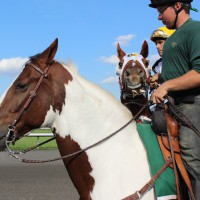Acid-base balance in horses

Horses are herbivores (grass eaters) and therefore they have an excess of base and excretes an alkaline urine (high pH value) which has a high concentration of bicarbonate. This is due to the fact that grass contain anions such as malic, aconitic and citric acids in the form of potassium, calcium and magnesium salts. When the anions are oxidized, hydrogen ions are removed and bicarbonate ions accumulate.
When horses do medium to high intensity exercise this results in an acidification of muscle and blood, the pH value decreases, with muscle fatigue as a consequence. These acid-base changes in exercising muscle and blood during medium to high intensity exercise are due to the anaerobic metabolism occurring in contracting muscle cells. Lactate and hydrogen ions are the acidifying end products of the muscle cells’ anaerobic metabolism. To analyze the concentration of lactate and measure the pH value in horses’ blood and muscle during exercise and recovery are the most common ways to determine the degree of acidification in the horses’ body.
A study on Standardbred trotters in training fed a forage-only diet compared to a 50:50 forage:concentrate diet has shown that the horses had higher concentrations of bicarbonate in plasma when they were fed forage only. The concentration of plasma lactate was also lower after exercise and blood pH higher during exercise when the horses were fed the forage-only diet compared to the forage:concentrate diet. So forage-only diets have positive effects on the acid-base balance in horses and you can read more about the acid-base study here.
Sara Muhonen, AgrD
